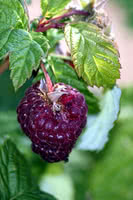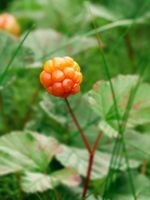Mon-Fri 9am - 5pm Mountain time
Royalty Raspberry vs Cloudberry
Rubus x Royalty
Rubus chamaemorus
NOT AVAILABLE THIS SEASON - MIGHT RETURN
Royalty Raspberry is a productive and delicious red-purple raspberry. It is a cross between a red raspberry and a black raspberry. Ripening in late August, the berries are ideal for homemade jams, preserves, and fresh eating.
If you are going for more of a classic red raspberry taste, pick the berries early. But if they are left on the cane until they are purple the taste will be sweeter.
Royalty Raspberry is a floricane-fruiting variety, meaning it primarily produces fruit on second-year canes (previous season’s new growth). They are also referred to as summer-bearing. In late winter or early spring, cut back all spent floricanes, leaving only last season's canes.
Raspberries are self-fertile, meaning they do not require cross-pollination from another variety to produce fruit.
This very popular extra large berried variety was developed at Cornell University.
Cloudberry produces berries which taste tart and tangy with a sweet, floral hint. The berries have a creamy texture when overripe. They are often used to make jams, juices, and liquors. The berries are a pale red colour and when ripe turn more orange/amber. They do not grow very tall, generally reaching only 10-25 cm.
Cloudberry has distinct male and female plants. In order to produce berries, both must be present and pollinate with each other. Berries are produced at maturity, typically 5-7 years, and produce 1 berry per stem. The plant spreads naturally as they grow using modified underground stems (rhizomes), forming more plants over time in the same area.
This plant can be found wild in Canada’s boreal forest. In Newfoundland and Labrador, this plant is known as the Bakeapple and is a significant regional food. Similarly the Côte-Nord region of Quebec also has a long history of using this berry.
Note: Cloudberries require very specific soil conditions. They need well-drained soil with a pH between 3.5 and 5.0. Also sensitive to salt and dry conditions.
Note: Our seedlings are grown from seed and are too young to identify their sex.

